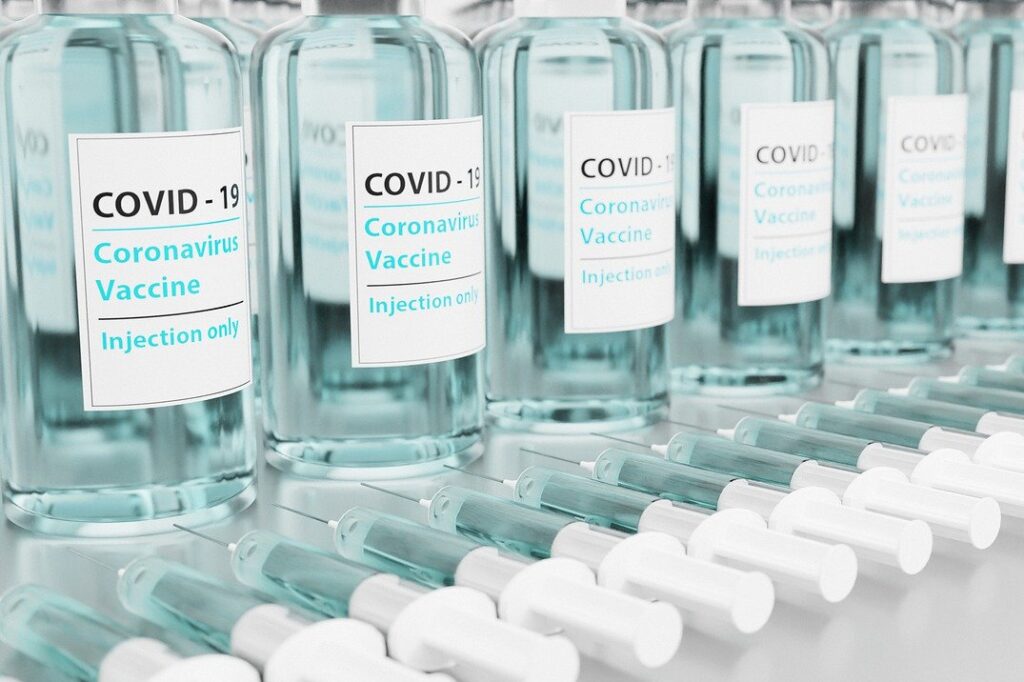Immunization Information Systems (IIS) are confidential, population-based, computerized databases where providers record all immunization doses administered. IIS are utilized by all states and some large cities and territories as consolidated databases for immunization history that can be used on both a micro and macro level to improve vaccine rates and reduce vaccine-preventable diseases. The COVID-19 pandemic underscored the need to improve IIS systems and use, including enhancing interoperability with other agencies, functionality, and staffing. In late July 2021, NASHP convened the Community of Practice (CoP) states to discuss opportunities to invest existing and new federal funds* to modernize IIS. This fact sheet summarizes key takeaways from that discussion around federal funding sources, strategic investments to update IIS, and state practices in data collection, use, and reporting.
*(from the Centers for Disease Control and Prevention (CDC) and the Center for Medicare and Medicaid Services (CMS)
Medicaid: Federal HITECH funding expired on 9/30/21 but states may qualify for federal Medicaid funds at a 90 percent match rate to support plan, design and implementation of IIS and 75 percent match rate where IIS is compliant with and supports Medicaid Management Information Systems.
CDC Epidemiology and Laboratory Capacity (ELC): CARES Act Project C2: Data Modernization (7/21/21): CDC awarded $200M to the CDCs 64 jurisdictions with the intention to accelerate recipients implementation of data modernization, including more complete data sharing across the public health ecosystem.
Tier 1: Core Data Modernization Infrastructure ($46 M total): Funding was awarded in the ELC Budget to allow jurisdictions to lead and coordinate data modernization in their health jurisdictions, including implementing workforce enhancements to accelerate modernization, and improving data quality, exchange, management, and use. Funding was awarded in ELC Budget Period 3 (August 1, 2021-July 31, 2022) for a 24-month project and will end July 31, 2023.
CDC National Center for Immunization and Respiratory Disease COVID Supplemental Funding
Core Cooperative Agreement: Immunizations and Vaccines for Children Program
Flu/COVID Supplement (June 2020): $140 million to 64 jurisdictions to enhance influenza vaccination coverage as a critical part of COVID-19 response activities
COVID/VFC Supplement 1 (September 2020) $200 million to 64 jurisdictions to develop and implement a COVID-19 vaccination plan.
COVID Supplement 2 (December 2020): $140 million to 64 jurisdictions to further support the implementation of COVID-19 vaccination activities.
COVID Supplement 3 (January 2021): $3 billion to 64 jurisdictions, with funding available through June 30, 2024 to implement and expand COVID-19 vaccination programs with a special emphasis on high-risk and underserved populations including racial and ethnic minority populations and rural communities.
COVID Supplement 4 (April 2021): $3.15 billion to 64 jurisdictions (available starting May 5, 2021 with funding available through June 30, 2024) to ensure greater equity and access to COVID-19 vaccine by those disproportionately affected by COVID-19.
NCIRD COVID-19 Supplement 4 Addendum May 2021
COVID Supplement 4 Addendum(May 2021): $243.75 million to 64 jurisdictions to develop and implement a vaccine confidence strategy.
Which IIS functionalities can be modernized?
- Provider onboarding (offices, pharmacies, non-traditional providers, etc. including rapid enrollment)
- Scheduling and schedule management capabilities
- Consumer access
- Evaluation & Forecast
- Data Quality (including matching data and enhanced record deduplication)
What activities can be automated or enhanced to help reduce staff time?
- Data Analytic Capacity (software/data visualization tools)
- Immunization Records Management (deduplication of records)
- Vaccine Inventory Management
- Mass Vaccination Clinic Operations (scheduling, check-in, recording, interoperability with IIS)
What gaps can be filled to help facilitate public health activity?
- Provide Public Data Access
What tasks can support IIS interoperability, integration, and outreach with partner systems like Medicaid and Public health?
- Outreach surveillance integration of partner systems including Medicaid and Public Health, as well as other systems like school health
- Coverage assessment enhancements for providers, schools, health plans, and health organizations
Data Collection on Immunization Rates for Children and Pregnant People
- All but one CoP states Medicaid divisions collect immunization data from IIS (LA, MI, WI, WA, WY). Due to incomplete IIS dataset collection, the other (TX) gets data from a variety of sources.
- States vary in their IIS data completeness due to lack of standardized reporting processes across providers and work to supplement their existing data through additional immunization data sources such as the Pregnancy Risk Assessment Monitoring System (PRAMS), Behavioral Risk Factor Surveillance System (BRFSS), billing/claims data, Vaccines For Children (VFC), and National Immunization Survey.
Data Use to Improve Immunization Rates
- All 6 states use IIS data to generate automated reports on coverage by geography, practice/delivery site and/or school
- Most of the CoP states use IIS data to determine pockets of need (LA, TX, WA, WI, WY), including specifically for mapping and data visualization purposes (TX, WA, WI, WY), as well as for Medicaid quality improvement reporting (LA, MI, WA, WI, WY).
- Half of the CoP states use immunization data for Medicaid quality improvement strategies including identifying populations with low vaccination rates to help inform outreach to Medicaid enrollees via managed care organization (MCO) partners (LA, WA, MI).
Reporting Requirements
- Four out of six surveyed states Medicaid programs require IIS reporting including: all age reporting requirement of all vaccines (LA, WY), required reporting for 18 and under (TX) and required reporting for 20 and under (MI)
- One state (MI) penalizes school districts for not meeting a 90% immunization compliance of entering students in school districts, with 5% of state funds being withheld if the districts do not report meeting requirements.
Data Sharing
- Almost all states share immunization data between Medicaid (and Medicaid managed care entities) and Public Health Immunization Programs (TX, LA, WI, WA, MI) with varying levels of frequency and ability. WY anticipates data sharing to be possible between Medicaid and Public Health Immunization programs by the end of 2021.
- Three states in the CoP facilitate collaboration among IIS and safety net programs such as WIC (Special Supplemental Nutrition Program for Women, Infants, and Children) (MI, WI, WY).
- Across all CoP states there is IIS participation among providers, including pediatricians, family practice physicians, hospitals, and retail pharmacies.
Select CoP state self-reported successes include:
- Vaccines for Children program (VFC) reaches high rates of children (TX VFC serves nearly 50% of children in the state)
- All VFC sites report immunization data to IIS (WI)
- School immunization reporting requirements (MI, WY). Michigan requires all licensed child care programs and schools to submit immunization reports, and schools that do not submit will be penalized. Wyoming has a 30-day exclusion rule that mandates schools to exclude those who are not fully vaccinated, have an approved exemption, or have a plan to get vaccinated within the first 30 days of school.
IIS Funding Approaches
- Many state IIS are funded through federal grants such as CDC cooperative VFC grants, as detailed above (LA, TX, WI, WY). Some states supplement and support their IIS through Medicaid matched funds (MI, WA, WI) and others supplement further through other grant and state funding (TX, WA).
- CDC: Justification of Estimates for Appropriation Committees, FY2022 IZ and other respiratory diseases budget request information on pg. 59.
- CDC: COVID-10 State, Tribal, Local and Territorial Funding Summary Overview of funding that has already been distributed.
- AIRA: Landscape Analysis: IIS Adult Vaccination Data Capture and Data Utilization Policies, practices, challenges, and successes that exist within the current adult vaccination environment as they relate to reporting practices, capture, and utilization of adult vaccination data in an IIS.
- CDC: Immunization and Vaccines for Children Program COVID Cycle 3 and Cycle 4 Supplemental Funding Frequently Asked Questions site
- ASTHO: FY22 Presidents Budget Proposal: A Public Health Snapshot Administrations budget priorities.
- ASTHO: Emergency Supplemental Funding to State, Local, Territorial, and Tribal Governments
- Duke-Margolis: Modernizing Immunization Information Systems
Acknowledgements:?The author thanks NASHP colleagues Sandra Wilkniss, Shelley Fiscus, and Ella Roth for their review of this product, and their colleagues at Academy Health and Immunize Colorado, as well as the state official participants in the Community of Practice. This fact sheet is supported by the Centers for Disease Control and Prevention (CDC) of the US Department of Health and Human Services (HHS) as part of a financial assistance award totaling $250,000 with 100 percent funded by CDC/HHS. The contents are those of the author and do not necessarily represent the official views of, nor an endorsement, by CDC/HHS or the US government. CDC General Terms and Conditions for Non-research Awards, Revised: February 2021.




